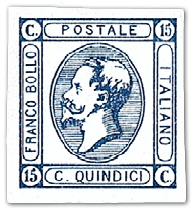
After some casting around for expertise in the newfangled art of stamp printing, the government settled on the house of Francesco Matraire in Turin. Matraire produced stamps with an embossed profile of Victor Emmanuel II.
Matraire of Turin also produced a distinctive 15c. stamp, the first designed specifically for the new kingdom, hence the inscription FRANCO BOLLO ITALIANO (Italian Postage Stamp). The stamp was lithographed pending receipt of a supply of stamps printed by De La Rue. Two versions of the stamp exist. The first ‘C’ in the bottom inscription is almost closed, while in the second the ‘C’ is open and the line below ‘Q’ of QUINDICI is broken.
 Other states in Italy also issued stamps during the 1850s: Modena, Naples, the Papal States, Parma, Romagna, Sicily, and Tuscany.
Other states in Italy also issued stamps during the 1850s: Modena, Naples, the Papal States, Parma, Romagna, Sicily, and Tuscany.Matraire's stamps were reprinted several times, and those printed after 17 March 1861 are normally considered the first stamps of Italy. During 1860 and 1861 "Sardinian" stamps supplanted those in use in each of the territories that joined Italy, with Modena, Parma, and Romagna changing over on 1 February 1860, and Naples not converting until 15 September 1862 (although the local authorities had earlier printed stamps featuring the arms of Savoy).
Perforated stamps began in 1862 and, starting on 1 January 1863, uniform postal rates went into effect. In 1862 Count Ambjörn Sparre won the stamp contract, but his designs were not liked, and he seemed unable to produce the stamps. In danger of running out of stamps altogether, at the end of 1862 the Italian government once again turned to Matraire, who quickly produced a 15c value by lithography.
Sparre's contract was cancelled in March 1863, and a new contract let to the British printer De La Rue, who produced a series of eight types ranging from 1c to 2l. They continued in use until the end of 1889.
Italy joined the Universal Postal Union on 1 July 1875.
Humbert I
Victor Emmanuel III
The world's first official airmail stamps were issued in 1917 when Poste italiane overprinted their existing special delivery stamps. Thus Italy achieved fame by being the first country to issue a stamp for use of its air mail (which took the form of an overprint on the 1903 “Inland Express Letter” stamp, 25c. rose)
On-line specialised Italy catalogue.
You've shared Stamps, it's really very special. And you have provided information about stamps, it is very important.
ReplyDeleteThank you so much
Pincodezone